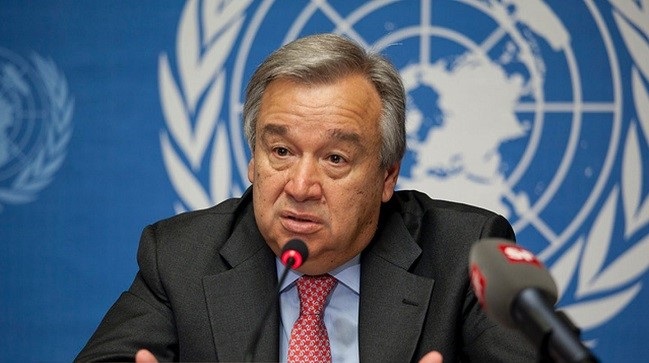UN Climate Change on Friday, February 26, 2021 published the Initial NDC Synthesis Report, showing nations must redouble efforts and submit stronger, more ambitious national climate action plans in 2021 if they’re to achieve the Paris Agreement goal of limiting global temperature rise by 2°C – ideally 1.5°C – by the end of the century.

“2021 is a make or break year to confront the global climate emergency. The science is clear, to limit global temperature rise to 1.5C, we must cut global emissions by 45% by 2030 from 2010 levels. Today’s interim report from the UNFCCC is a red alert for our planet. It shows governments are nowhere close to the level of ambition needed to limit climate change to 1.5 degrees and meet the goals of the Paris Agreement.
“The major emitters must step up with much more ambitious emissions reductions targets for 2030 in their Nationally Determined Contributions well before the November UN Climate Conference in Glasgow,” said UN Secretary-General António Guterres.
“Now is the time. The global coalition committed to net-zero emissions by 2050 is growing, across governments, businesses, investors, cities, regions and civil society. COVID-19 recovery plans offer the opportunity to build back greener and cleaner. Decision makers must walk the talk. Long-term commitments must be matched by immediate actions to launch the decade of transformation that people and planet so desperately need,” he added.
The report was requested by Parties to the Paris Agreement to measure the progress of national climate action plans – known as NDCs – ahead of COP26 this November. Covering submissions up to 31 December 2020, it shows 75 Parties have communicated a new or updated NDC, representing approximately 30 per cent of global greenhouse gas emissions.
“This report shows that current levels of climate ambition are very far from putting us on a pathway that will meet our Paris Agreement goals,” said Patricia Espinosa, Executive Secretary of UN Climate Change. “While we acknowledge the recent political shift in momentum towards stronger climate action throughout the world, decisions to accelerate and broaden climate action everywhere must be taken now. This underlines why COP 26 must be the moment when we get on track towards a green, clean, healthy and prosperous world.”
The report shows that while the majority of nations represented increased their individual levels of ambition to reduce emissions, their combined impact puts them on a path to achieve a less than 1 per cent reduction by 2030 compared to 2010 levels. The Intergovernmental Panel on Climate Change, by contrast, has indicated that emission reduction ranges to meet the 1.5°C temperature goal should be around 45 per cent lower.
Espinosa clarified that the Synthesis Report is a “snapshot, not a full picture” of the NDCs as COVID-19 posed significant challenges for many nations with respect to completing their submissions in 2020. She indicated that a second report will be released prior to COP26 and called on all countries – specifically major emitters that have not yet done so – to make their submissions as soon as possible, so that their information can be included in the updated report.
“We congratulate Parties that rose to the challenges posed by COVID-19 in 2020, honoured their commitments under the Paris Agreement and submitted their NDCs by the deadline,” said Ms. Espinosa, “but it’s time for all remaining Parties to step up, fulfil what they promised to do under the Paris Agreement and submit their NDCs as soon as possible. If this task was urgent before, it’s crucial now.”
She noted that 2021 gives the world an unprecedented opportunity to make significant progress on climate change and urged all nations to build forward from COVID-19 with more sustainable and climate-resilient economies. “This is a rare moment that cannot be lost,” Espinosa said. “As we rebuild, we cannot revert to the old normal. The NDCs must reflect this reality and major emitters, especially G20 nations, must lead the way.”
Incoming COP26 President Alok Sharma said: “This report should serve as an urgent Call to Action and I am asking all countries, particularly major emitters, to submit ambitious 2030 emission reduction targets”
“We must recognise that the window for action to safeguard our planet is closing fast”, he added.
COP25 President Carolina Schmidt noted that the NDC Synthesis Report “clearly indicated that significant work must be done, in particular by major emitters. Only two of the 18 largest emitters, the UK and the European Union, presented an updated NDC in 2020 containing a strong increase in their GHG reduction targets. Other major emitters either submitted NDCs presenting a very low increase in their ambition level or have not presented NDCs yet.
“Even though the Synthesis Report shows that the NDCs submitted in 2020 are clearer and more comprehensive than the first round, for example containing more information on adaptation, and greater alignment with the Sustainable Development Goals, the overall level of ambition exhibited by major emitters in this first snapshot is very low.”
Espinosa encouraged all nations, even those who have submitted new or updated NDCs, to investigate further areas in order to create more robust NDCs. She added that an increase in ambition must be accompanied by a significant increase in support for climate action in developing nations, fulfilling a key element of the Paris Agreement.
